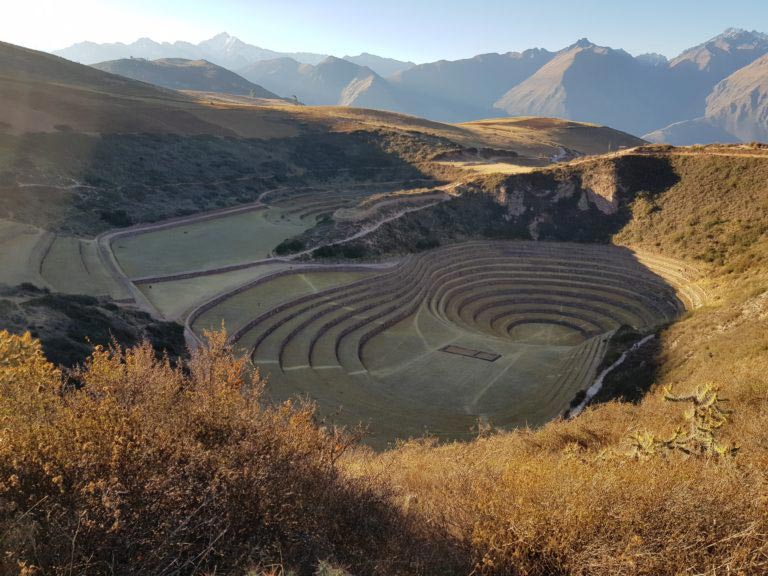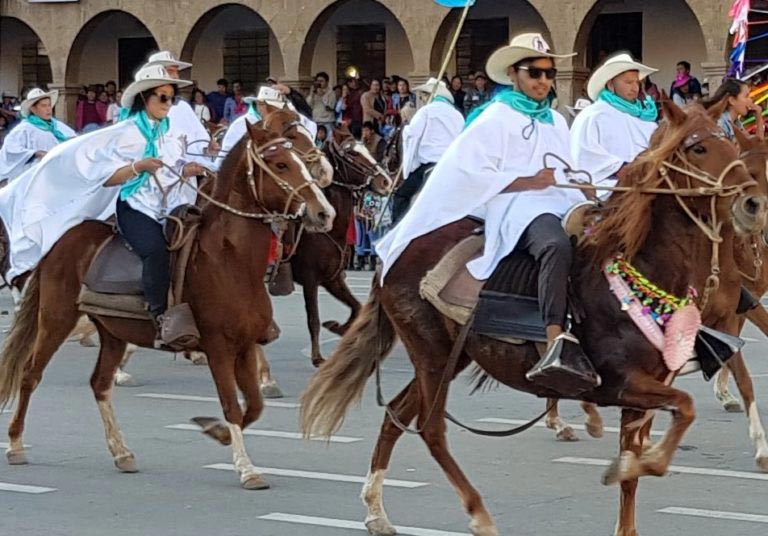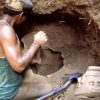Did God conquer the Incas?
I choose three dry coca leaves out of Franco’s bag, tuck them inside my cheek and open my lungs to welcome thinning Andean air. Llamas graze on nearby slopes. Eagles float overhead. A distant glacier reflects the midday sun. We are resting on a saddle, 14,400 feet above sea level, in Peru’s Sacred Valley. The utter silence around us and the deep blue overhead are therapy. With no need for words, we descend to an alpine lake as sunlight conjures nature’s better diamonds on the water.
For those with ears to hear, these rocky peaks and verdant valleys are full of stories. Carved stone terraces above the Urubamba river testify to a grand century of Incan dominion; stately Spanish churches in the villages below announce Christian supersession. Andean farmers, herders and artisans see no reason to choose between the two. It was a Saturday, November 16th, spring of 1532, when another Franco lured the reigning Inca lord into the great square of Cajamarca in northern Peru, 8,900 feet above sea level. That figure was Don Francisco Pizarro, Governor General and conquistador, on whose signal four cannons ignited and nine primitive muskets fired point blank into the crowded mass of Inca warriors.

Our friend, Franco, shares coca leaves with a farmer we meet during our hike.
At the blast of a trumpet, Pizarro’s tiny fighting force of sixty-two horsemen and 106 foot soldiers, mostly in their twenties, advanced against a foe 500 times as numerous. Within a couple of hours, that handful of fearful fighters had conquered the greatest empire the Americas had ever seen and taken captive the empire’s Inca lord, Atahualpa.
For Francisco Pizarro, devout Christian, this improbable victory was an act of God:
The fifty-four-year-old conquistador fully believed in divine providence. He also believed that God had intervened today on the side of the slashing, blood-spattered Christians on the square. The proof lay in Atahualpa’s capture and in the fact that so many had been killed by so few. The Inca emperor and his subjects were nonbelievers, after all, whose souls, without conversion, were destined for hell. Though blood had been spilled, Pizarro was convinced that in the end it would be he and his conquistadors and their bloody swords that would bring the great mass of nonbelievers into the sacred fold of the Lord.1

Moray terraces. Sacred Valley, Peru.
Pizarro’s conviction that Peru’s conquest was a miracle was widely shared. In July of 1533, Gaspare de Gárate, one of Pizarro’s young pages, testified in a poignant letter to his father:
We took [captive] this lord [Atahualpa] by a miracle of God because our forces wouldn’t be enough to take him nor to do what we did, but God gave us the victory miraculously over him and his forces.2
As historiography became hagiography, storytellers would speak of heavenly forces fighting alongside the Spanish. According to Father Naharro, the Indians were terrified by an apparition during the battle:
a woman and a child, and, at their side, a horseman all clothed in white on a milk-white charger, – doubtless the valiant St. James, – who, with his sword glancing lightning, smote down the infidel host, and rendered them incapable of resistance.3

Mamacha Asunta Festival in Calca, Sacred Valley, Peru.
What else but divine intervention could explain the instant, sweeping and durable defeat of a warrior force 80,000 strong, whose divine commander ruled some 10 million peasants, spread over territory twice the size of the Iberian peninsula?
Christians through the years have often attributed to heaven the outcome of earthly battles. And not just battles. Elections and negotiations are also said to be directed by “a Superintending providence.”4 God even gets credit for steering hurricanes and forest fires.
How should we respond when Christians declare some (in-their-mind-favorable) historical outcome to be the work of God?
It was God, we hear, who raised up Donald Trump. Like King Cyrus of old, he is rescuing America from a liberal Supreme Court and cultural collapse.5 Like Queen Esther, he is saving Israel from a resurgent Persian (i.e., Iranian) menace.6 Never mind the man’s imperfections, we are told. God uses broken vessels to accomplish his will.
Likewise, how should we respond to Christian Zionists like Vice-president Mike Pence who declare the birth of modern Israel as an act of God? Surely only divine intervention could explain the triumph of a handful of Zionists over the Arab hordes.
How should we respond to miracle detectives today? What should we do when a person of faith declares an historical event to be an act of God?

Farmers in Huayllafara clearing land and preserving ancient traditions.
We might start by doing our homework. Historians of Pizarro’s conquest of the Incas list various mundane factors that would have given the competitive edge to Spain. Bronze-age Peru was no match for Iron-age Spain. Guns and steel weapons were far more lethal than clubs, stone axes and slingshots, and psychologically far more terrifying. Spanish shields and helmets were less penetrable; seaworthy ships aided communication and ferried needed reinforcements; horses gave them speed, maneuverability and intimidation; and literacy meant reports of previous battles and knowledge of human behavior.7
Whatever else was in their favor, superior weapons insured the Spaniards’ continued success. As Jared Diamond explains:
The novelty of horses, steel weapons, and guns undoubtedly paralyzed the Incas at Cajamarca, but the battles after Cajamarca were fought against determined resistance by Inca armies that had already seen Spanish weapons and horses. Within half a dozen years of the initial conquest, Incas mounted two desperate, large-scale, well-prepared rebellions against the Spaniards. All those efforts failed because of the Spaniards’ far superior armament.8
And if military superiority isn’t enough, we should mention the diseases that stowed away on European ships—the “germs” in Jared Diamond’s haunting triad: Guns, Germs and Steel. It was smallpox, apparently, that decimated the Inca masses and felled both their emperor, Huayna Capac, and his appointed heir, Ninan Cuyuchi. If this silent killer prompted a power struggle among the Inca’s sons, it led also and conveniently to a weakened and divided empire on the eve of Pizarro’s arrival.9 Nor can we dismiss the impact of torture, terror, rape and deception in Pizarro’s campaign.
The battle of Cajamarca in 1532 was certainly remarkable, but its outcome is far less mysterious to us than it was to Pizarro and his youthful warriors at the time. Horses and steel trump clubs and bows.
When we declare history’s victors to be God’s chosen agents, do we turn the vanquished into objects of divine wrath, and brand their sympathizers as God’s enemies? Should not the historian’s hindsight temper any urge to identify divine fingerprints in the confusing swirl of history? Perhaps Trump’s victory in America and the Zionists’ conquest in Palestine, like the Spanish conquest of Peru, will appear less surprising the longer and more closely we look.
What do you think?
How do we discern the hand of God in history?
Is every historical outcome a direct act of God?
Why do nations justify territorial conquest by ascribing the outcome to God?
- Kim MacQuarrie, The Last Days of the Incas (Simon & Schuster, 2007), 89; cf. William Prescott, The Conquest of Peru, loc. 5016, 5095.
- MacQuarrie, Last Days, 125; cf. Diamond, Guns, loc. 1170. Emphasis added.
- Prescott, Conquest, 5039. This was not Pizarro’s only heaven-aided victory. On the earlier battle of Puná, see Prescott, Conquest, loc. 3975; on the later siege of Cusco, ibid, loc. 6771.
- From Benjamin Franklin’s call for prayer at the Constitutional Convention, June 28, 1787 <https://www.americanrhetoric.com/speeches/benfranklin.htm> (accessed 8-24-19). For an eloquent defense of God’s hand in U.S. history, see the sermon by Rev. Henry Smith, preached August 6, 1863.)
- See David Brody’s USA Today reflection (Oct. 2018): USA Today, or Katherine Stewart’s opinion piece in the NYT (Dec 2018): NY Times.
- Warm to this idea is none other than U.S. Secretary of State, and Evangelical Christian, Mike Pompeo: CBN. See also Edward Wong (NY Times), Carol Kuruvilla (Huffpost), and Dana Milbank (Washington Post).
- MacQuarrie, Last Days, 142.
- Diamond, Guns, Germs and Steel, loc. 1193.
- MacQuarrie, LastDays, 47, 142-45; Diamond, Germs, loc.1240, 3445. Arguing against the consensus that smallpox caused a demographic catastrophe are Robert McCaa, Aleta Nimlos and Teodoro Hampe- Martínez, “Why Blame Smallpox? The Death of the Inca Huayna Capac and the Demographic Destruction of Tawantinsuyu (Ancient Peru)” (American Historical Association Annual Meeting, January 8-11, 2004, Washington D.C.).







